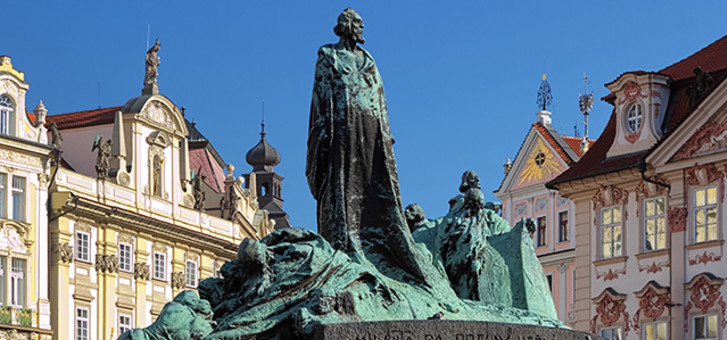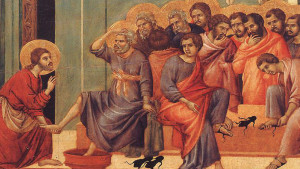John Huss (sometimes spelled Jan Hus) was born around 1373 in the southern part of what is now the Czech Republic. His father died soon after his birth, but his mother made sure Huss was well educated. She sent him to a school in a nearby town and when he was older she travelled with him to Prague to enrol him in a university. As they entered Prague, she prayed that God would keep her son true to Him.
Huss obtained two bachelor’s degrees, one in arts and the other in theology. He graduated in 1394 with a master’s degree in theology. Five years later, he was ordained a priest in the Catholic Church. The next year he was appointed the dean of the faculty of philosophy and in 1402 he served as rector for the University of Prague. Huss seemed destined for a luminous career.
Huss preached from the Bible in the then recently built Bethlehem Chapel and attracted thousands of hearers and followers. He became noted for three things:
First, he preached the gospel, teaching people that they were saved through faith in Jesus Christ.
Second, even though the pope had forbidden the reading of the Bible (except by priests) and preaching in local languages, Huss continued to attract crowds by doing just that.
Third, Huss saw the moral laxity of his church leaders. The local archbishop had recently purchased the office he held and Huss condemned this and other corrupt practices. Like Martin Luther, Huss preached against the church’s practice of selling indulgences (a type of pardon for sins committed).
Huss’s actions infuriated church leaders and he was called to account for them. Huss had been studying the writings of the English Reformer John Wycliffe and he was ordered to bring Wycliffe’s writings with him. These were confiscated and burned, and Huss was ordered to leave Bethlehem Chapel, which he refused to do.
In 1411, an order for Huss’s arrest was issued along with an order to burn Bethlehem Chapel. But because of popular support for Huss and his cause, neither order could be carried out. However, the Catholic Church’s fury against Huss became so great that the king of Bohemia suggested he go into exile for a while.
The Council of Constance
The Council of Constance was an ecumenical council organised by the church. Meeting from 1414 to 1418 in 45 sessions, it was called under intense pressure by the Holy Roman Emperor, Sigismund of Luxembourg (or Germany). At the time, three men were claiming to be pope and the primary purpose of the council was to reunite the whole of Christendom. John XXIII was one of the popes at the time and he called the council. Another of the council’s purposes was to refute the teachings of Wycliffe and Huss.
Constance is a city on Lake Constance on the border between today’s Germany and Switzerland. Its population of 5500 expanded several times over, thanks to the arrival of some 30 cardinals, 20 archbishops, 150 bishops, 800 priests and many more dignitaries and onlookers.
Huss was summoned to appear before the council and was granted safe conduct by both Emperor Sigismund and the Church, which meant that he would be allowed to leave the city when his trial was over. While he could have survived in the anonymity of exile, he chose to travel to Constance.
However, Sigismund, believing Huss to be a heretic, disregarded the safe conduct! Shortly after his arrival, Huss was arrested, shackled and thrown into the dungeon of the Dominican Convent on Constance Island, a small island near the shore of the lake. It is said that the dungeon was below water level, with the town sewer flowing through it. Huss became sick and many despaired for his life, so he was moved to the Gottlieben Castle, a few kilometres from the lake. He was still chained and not permitted any writing materials. Ironically, Pope John XXIII, who had volunteered to step down from his title if the other two popes did the same, was arrested on his way out of Constance and imprisoned along with Huss!
Four hundred and twenty-five Czech nobles wrote to the council protesting the treatment of Huss. They were summoned to the council, but wisely none of them obeyed.
The trial
Huss was charged with disregarding the discipline of the church and rejecting some of its doctrines. On the last day of his trial, he faced 30 charges, some so preposterous as to defy belief. But Huss refused to recant his heartfelt beliefs, declaring that he had never taught the false doctrines ascribed to him.
As for the charge of preaching what the council considered wrong, Huss never wavered from his position and said he could not renounce errors he had never held. He asked to be shown from Scripture wherein he was in error—a request that was refused. Instead, he was told that he was plain obstinate.
Finally, on July 6, 1415, he was condemned as a heretic, deposed, degraded from the priesthood and delivered to the civil powers to carry out the death sentence.
Wearing a dunce’s cap bearing the words “Prince of heretics,” Huss was led to the stake, surrounded by 1000 armed men and burned to death. Translations of Wycliffe’s English Bible were used to light the fire, showing the connection between Wycliffe and Huss.
And as the flames began to rise, Huss sang, “Jesus, Son of the living God, have mercy on me.”
What Huss means to us
To the chagrin of the council, Huss’s ideas didn’t die with him. Prague and its surrounding areas became predominantly Protestant for many years, with nine out of 10 people affirming Protestant beliefs.
The religious historian Philip Schaff wrote, “It is doubtful, if we except the sufferings and death of Jesus Christ, whether the forward movement of religious enlightenment and human freedom have been advanced as much for the sufferings and death of any single man as by the death of Hus.”
Ironically—or perhaps poetically—just over 100 years later, in the 1520s, the city of Constance became entirely Protestant. With the survival of the Hussites, the church, at the Council of Basel (1431–1449), finally granted ecclesiastical independence to the Hussites, for the first time creating a form of religious tolerance.
Luther said, “We have all been Hussites without knowing it.”
Five hundred years after his death, Huss became the moral hero of Czech society. A large statue of him was erected in the centre of Prague and the Hussite Museum in Tábor has put together a travelling exhibition commemorating 600 years of his martyrdom. The hope is that the importance of Huss’s life will be remembered and that his beliefs, rooted and grounded in the Bible as they were, will be recognised.




